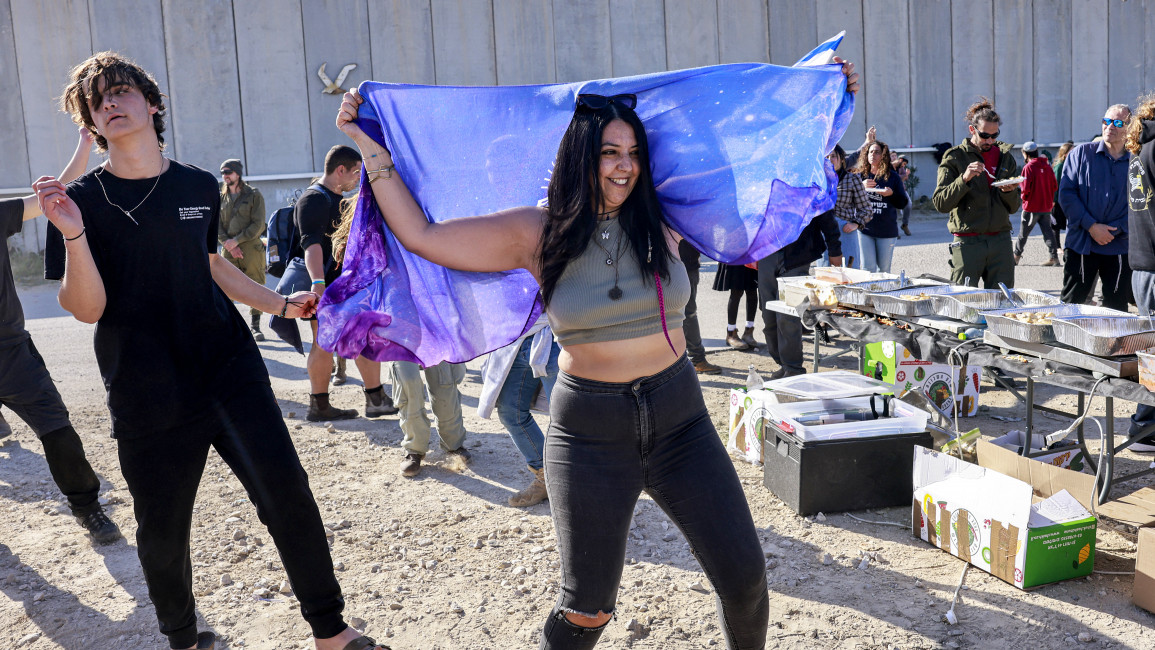Israelis dance, camp out at Gaza crossing while blocking aid for Palestinians
Dozens of Israelis have set up camp by the Karem Abu Salem border crossing this week to block the entry of trucks carrying desperately needed aid into Gaza.
The demonstrators have disrupted access for at least 100 trucks on their way to the besieged strip, where for weeks UN agencies have been warning that the war-ravaged population is on the brink of famine.
Some of the Israelis are from far-right groups while others are relatives of the hostages held by Hamas inside Gaza, and are demanding that aid is stopped until all captives are returned.
The Israeli public began targeting the aid trucks following growing doubts over Prime Minister Benjamin Netanyahu's ability or desire to see the return of the 136 hostages.
Footage shows men, women and children standing by the border wall holding Israeli flags and banners, with some calling for the release of the hostages while others claim that aid is going to Hamas.
In one video, groups of men and women can be seen jumping up and down dancing to electronic rave music booming from a bloc speaker in a festival-like scene.
Israel Hayom, a Hebrew-language daily newspaper, shared a video on X which showed tents pitched up by the tall concrete border wall alongside crowds of people gathered around makeshift camp fires during Wednesday night.
מעבר כרם שלום נחסם לתנועת משאיות הסיוע לחמאס.
— igal_malka (@igal_malka_5G) February 6, 2024
הביטי היטב עזה.
עוד נרקוד בחורבנך. pic.twitter.com/j5AK2SFYGz
One protester interviewed in a recent video by AP agency said that if the hostages were returned, they would cease the action. "We cannot just carry-on feeding Hamas and getting nothing," she said.
"No one’s going to fight the lorries going in if hostages are coming out that is 100 percent".
Another woman interviewed by AP said that the aid for Gaza was "strengthening the very enemy we are fighting against".
There is a common belief among the Israeli public that the aid is being confiscated and used solely by Hamas, with such unfounded claims being peddled by right-wing politicians and officials.
A report from the United Nation's Human Right's office in January described the depths of the humanitarian emergency in Gaza. It said that a quarter of the population is starving and struggling to find food or drinking water, with pregnant women and children the most vulnerable.
The Israeli military banned civilians from entering the crossing zone in response to the protests which have been going on for nearly two weeks, but this has failed to deter them.
The protesters are a collection of groups, one of which is the Tzav 9 (Order 9) movement which is a reference to the Order 8 emergency notice declared by the Israeli army to mobilise reservists following the October 7 attacks.
Tzav 9 say that no aid should enter Gaza until the hostages are released while they ascertain that the aid is not reaching the hostages.
Netanyahu opened the second crossing point of Karem Abu Salem in December after conceding to pressure from the international community to improve aid access for Palestinians.
The move has also enabled him to use it as leverage for the continuation of his brutal campaign in Gaza.
The protests have exacerbated an already dire delivery situation in which around 50 to 100 trucks carrying dry food, water, and medicines, among other vital supplies, are making it through to Gaza each day.
Aid groups have compared this to a "drop in the ocean", saying that 500 trucks daily are needed to meet the demands of the 2.3 million population.
Stringent measures in place by the Israeli authorities mean each vehicle is checked numerous times, further delaying their arrival.


![President Pezeshkian has denounced Israel's attacks on Lebanon [Getty]](/sites/default/files/styles/image_684x385/public/2173482924.jpeg?h=a5f2f23a&itok=q3evVtko)



 Follow the Middle East's top stories in English at The New Arab on Google News
Follow the Middle East's top stories in English at The New Arab on Google News


